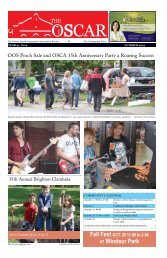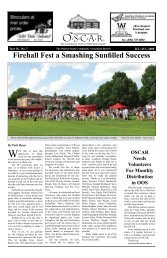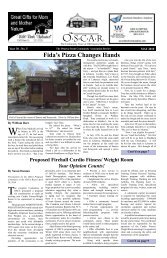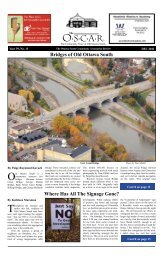O•S•C•A•R© Shop Your Local! - Old Ottawa South
O•S•C•A•R© Shop Your Local! - Old Ottawa South
O•S•C•A•R© Shop Your Local! - Old Ottawa South
You also want an ePaper? Increase the reach of your titles
YUMPU automatically turns print PDFs into web optimized ePapers that Google loves.
Page 14<br />
By John M. Calvert<br />
Every year, infill development and<br />
intensification bring substantial changes to<br />
our neighbourhood. In some cases this results<br />
in complete demolition, such as 900 Colonel By<br />
Drive (see The OSCAR November 2008). We seem<br />
to be gradually losing our cultural heritage and the<br />
essential character of our neighbourhood. What can<br />
we do to protect our built cultural heritage?<br />
<strong>Old</strong> <strong>Ottawa</strong> <strong>South</strong> has a number of well-recognized<br />
heritage landmarks, including the <strong>Old</strong> Firehall,<br />
the Bank Street Bridge, and <strong>South</strong>minster United<br />
Church, but not all of these are protected. There are<br />
currently six public and private properties designated<br />
for protection under the Ontario Heritage Act, and<br />
The OSCAR - OUR 36 th YEAR<br />
OTTAWA SOUTH HISTORY PROJECT<br />
Protecting Our Cultural Heritage in <strong>Old</strong> <strong>Ottawa</strong> <strong>South</strong><br />
another one (Mayfair Theatre) is currently under<br />
consideration for designation. There are likely other<br />
properties in <strong>Old</strong> <strong>Ottawa</strong> <strong>South</strong> that merit formal<br />
protection under the Ontario Heritage Act.<br />
The Ontario Heritage Act provides for<br />
protection of culturally significant properties. The<br />
Act can be applied to individual properties or to<br />
a conservation district which is a group of two or<br />
more related properties. Properties and districts are<br />
evaluated based on whether they have (1) design or<br />
physical value, (2) historical or associative value, or<br />
(3) contextual value. Heritage protection can apply<br />
to both the exterior and the interior of an individual<br />
building, or just the exterior of buildings in a<br />
district designation. When a property is designated,<br />
heritage planners prepare a Statement of Cultural<br />
Heritage Value or Interest that lists the attributes of<br />
the property that are protected. Only those features<br />
listed are covered by the legal protection, and all<br />
other attributes of the property are not.<br />
Some people are fearful of what a formal heritage<br />
designation for their property could mean, in large<br />
part because of misunderstandings about the effect<br />
of the designation. The most common concerns are<br />
that designation under the Heritage Act will result<br />
in burdensome restrictions on the property, which<br />
would affect the smallest maintenance or renovation<br />
project, and result in extra expenses to conform to<br />
the designation. Further, some fear they will find it<br />
difficult to sell the property, with a resulting loss in<br />
property value.<br />
In fact, research shows these fears to be<br />
unfounded. Dr. Robert Shipley of the School of<br />
Planning, University of Waterloo, has extensively<br />
studied heritage designation and its impact on<br />
property owners and property values. His research,<br />
along with others in the United States, shows that<br />
heritage designations have no measurable negative<br />
impact on property values, and in fact reveal a<br />
possible positive influence. Dr. Shipley is presently<br />
leading a province-wide study to update this<br />
research, including several conservation districts<br />
that are located in <strong>Ottawa</strong>.<br />
The Ontario Heritage Act allows municipalities<br />
to provide property tax relief of 10% to 40%, and<br />
to establish loan/grant programs to assist property<br />
owners in maintenance and restoration projects.<br />
The City of <strong>Ottawa</strong> has a grant program with a<br />
maximum grant per property per annum of $5,000<br />
matching funds, and is considering a property tax<br />
relief program.<br />
Many owners of designated heritage properties<br />
discover that there is a significant caché in a heritage<br />
designation and an enhanced pride of ownership.<br />
Such a designation can also enhance the market<br />
value of a property, as the designation highlights<br />
the unique attractiveness of the property.<br />
A less formal means of protection is simply to<br />
document and publicize properties with cultural<br />
significance. This is probably less effective<br />
than a formal designation, but is easier to gain<br />
consensus on and achieve. Given <strong>Old</strong> <strong>Ottawa</strong><br />
<strong>South</strong>’s recent history of rising to the challenge<br />
to defend our interests, this less formal means of<br />
protection is perhaps sufficient in the short term,<br />
but may not be enough to ensure a cultural legacy<br />
for our grandchildren and future residents of the<br />
neighbourhood.<br />
DEC 2008<br />
In any approach we choose to protect our<br />
heritage, several elements are essential:<br />
1. Community based perspective. Most<br />
successful heritage districts are initiated by<br />
community members themselves, not government.<br />
The broader the community base of support for the<br />
district, the more likely the chances of success, not<br />
only during the designation process, but also in the<br />
management of change over time.<br />
2. Value-based approach. A clear Statement of<br />
Value is one of the most important legal requirements<br />
of heritage designation. Experience shows that the<br />
Ontario Municipal Board will take into account<br />
heritage values when they are clearly and precisely<br />
identified.<br />
3. Inclusive view of heritage. Designation is not<br />
just about buildings, but can include the streetscape<br />
and landscape features and use patterns that form<br />
the glue holding properties together and sustaining<br />
their value.<br />
4. Strong basis in history. One of the key<br />
differences between heritage districts and other<br />
aspects of municipal planning is the use of history.<br />
Good historical research reveals more than just the<br />
past; it provides a way to understand the present and<br />
plan for the future.<br />
5. Dynamic view of heritage. With good<br />
historical research and a clear statement of values,<br />
a community can focus on enhancing things that<br />
are important and letting go of things that do not<br />
contribute. This creates a dynamic rather than static<br />
approach to heritage, although there is a basic<br />
framework of stability.<br />
Please contact the <strong>Ottawa</strong> <strong>South</strong> History<br />
Project with your thoughts on the use of heritage<br />
designations, for both individual properties and<br />
districts. If the community supports the above<br />
approach, we will be looking for volunteers in 2009<br />
to help conduct a heritage survey to identify and<br />
document individual properties and street blocks<br />
that might merit designation.<br />
Contact the <strong>Ottawa</strong> <strong>South</strong> History Project at<br />
HistoryProject@<strong>Old</strong><strong>Ottawa</strong><strong>South</strong>.ca or visit us<br />
online at www.<strong>Old</strong><strong>Ottawa</strong><strong>South</strong>.ca/HistoryProject.<br />
For further reading, see Dr. Shipley’s article:<br />
The Impact of Heritage Designation on Property<br />
Values. International Journal of Heritage Studies:<br />
6(1), 2000; or the Brookings Institution’s Economics<br />
and Historic Preservation - A Guide and Review of<br />
the Literature: 2005.<br />
The Ontario Heritage Act, Regulation 9/06:<br />
Criteria for Determining Cultural Heritage Value<br />
or Interest can be found at www.e-laws.gov.on.ca/<br />
html/regs/english/elaws_regs_060009_e.htm.<br />
Dr. Shipley’s Heritage Conservation District<br />
Study can be found at www.fes.uwaterloo.ca/<br />
research/hrc/research_and_education/index.html.










